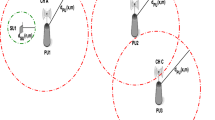Abstract
Cognitive radio is wireless communication system used for higher spectrum utilization for spectrum holes that are shared between primary (or licensed) users and secondary (or unlicensed) users. Primary service provider can sell unused holes for secondary service provider in which pricing is interested factor for market equilibrium. This process called spectrum trading. Pricing in spectrum sharing depends on spectrum demand from unlicensed users and requirements of primary users to gain payoff. In this paper, supermodular competitive game will be investigated considering Bertrand competition model among primary service providers, which is not clarified until now. In the competitive Bertrand game, the aim of spectrum trading process is to maximize the individual payoff or profit for each primary service provider. Moreover, genetic algorithm will be applied to demonstrate the effect of pricing in profit gained by primary service provider with optimizing profit function from abrupt changing in pricing and achieving market equilibrium.




Similar content being viewed by others
References
Haykin, S. (2005). Cognitive radio: Brain-empowered wireless communications. IEEE Journal on Selected Areas in Communications, 23(2), 201–220.
Niyato, D., & Hossain, E. (2008). Competitive pricing for spectrum sharing in cognitive radio networks: Dynamic game, inefficiency of Nash equilibrium, and collusion. IEEE Journal on Selected Areas in Communications, 26(1), 192–202.
Kim, Sungwook. (2013). Cognitive radio bandwidth sharing scheme based on the two-way matching game. Wireless Personal Communications, 68(3), 893–905.
Mackenzie, & DaSilva, L. (2006). Game theory for wireless engineers. San Rafael: Morgan & Claypool Publishers.
Shoham, Y., & leyton-Brown, K. (2009). Multiagent system, algorithmic, game theatric, and logical foundations. Cambridge: Cambridge University Press.
Richard Yu, F. (2011). Cognitive radio mobile ad hoc networks. Ottawa: Carleton University.
Qun, Yu. (2013). A survey of cooperative games for cognitive radio networks. Wireless Personal Communications, 73(3), 949–966.
Maharjan, Sabita, Zhang, Yan, & Gjessing, Stein. (2011). Economic approaches for cognitive radio networks: A survey. Wireless Personal Communications, 57(1), 33–51.
Niyato, D., Hossain, E., & Han, Zhu. (2009). Dynamic spectrum access and management in cognitive radio networks. Cambridge: Cambridge University Press.
Farraj, Abdallah K., & Hammad, Eman M. (2013). Impact of quality of service constraints on the performance of spectrum sharing cognitive users. Wireless Personal Communications, 69(2), 673–688.
Sharkey, W. W., & Sibley, D. S. (1993). A Bertrand model of pricing and entry. Economics Letters, 41, 199–206.
Mitchell, M. (1999). An introduction to genetic algorithms. Cambridge: MIT Press.
Sivanandam, S. N., & Deepa, S. N. (2008). Introduction to genetic algorithms. Berlin: Springer, ISBN:978-3-540-73189-4.
Singh, N., & Vives, X. (1984). Price and quantity competition in differenced duopoly. The RAND Journal of Economics, 15(4), 546–554.
Author information
Authors and Affiliations
Corresponding author
Rights and permissions
About this article
Cite this article
Salem, A.A., Shokair, M., Elkordy, M. et al. Profit of Price with Supermodular Game for Spectrum Sharing in Cognitive Radio Using Genetic Algorithm. Wireless Pers Commun 82, 2601–2609 (2015). https://doi.org/10.1007/s11277-015-2367-5
Published:
Issue Date:
DOI: https://doi.org/10.1007/s11277-015-2367-5




